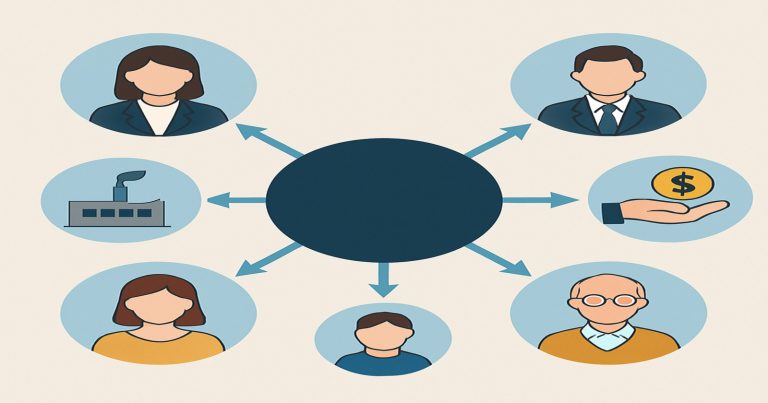Stakeholders are all the people like employees, customers, investors, suppliers, government, public. In the business world of today, stakeholder insights are incredibly important. Most of the time, you will be working with your clients, suppliers, and investors.
Stakeholders may be internal (employees, managers) or external (customers and local communities). Businesses need an understanding of who their stakeholders are if they are going to make more informed decisions. They should also read them in, engage them and please them. Students often ask, “What is a stakeholder?” or “Who are stakeholders?”
This article explains the stakeholder meaning, stakeholder definition, types of stakeholders, and stakeholder v/s shareholder. We will also go through stakeholder theory, stakeholder mapping and how to conduct a good stakeholder analysis. This piece is beneficial for students, professionals, or anyone wanting to grow business knowledge. We will cover description of all topics in simple words with examples from life. And by the end you’ll be able to know how to manage stakeholders in any business.
What is a Stakeholder? Meaning and Definition
The stakeholder is any individual, group, or organization that is concerned with, or interested in, a business or project. They can affect the business, and the business can affect them in return.
People who will be impacted by your product/service/solution could include both internal (i.e., employees) and external (i.e., customers) people. The government can also be a stakeholder. The stakeholder is one that stands to achieve or lose business. The most common types of stakeholders are:
- Employee
- Managers
- Investors
- Customers
- Suppliers
- Local community
- Government bodies
- NGO
- Pressure Group
Types of Stakeholders
There are different heads of stakeholders based on how they associate with the company. Knowing the types make it easier to interact with one another effectively and to decide best.
Internal and External Stakeholders
Internal stakeholders are individuals within the organization. They include:
- Managers
- Employees
- Business owners
These individuals work directly with or manage the business. More precisely, they are concerned with salary, job stability, promotions and the overall success of the company.
External Stakeholders are outside the business. They include:
- Customers
- Suppliers
- Lenders
- Local community
- Government agencies
They are not employees, but you affect their lives and businesses.
Primary and Secondary Stakeholders
The primary stakeholders are actively involved with business. Based on business decisions, their interests can be aligned or incorrectly aligned.
Example-consumer, labor and investor
Secondary stakeholders are those who are neither directly connected but affected.
Example: Media, Contestants and pressure groups
Once you understand the types, stakeholder mapping is easy.
Stakeholder vs Shareholder
People tend to confuse stakeholders and shareholders. But they are not. Their roles, rights and interests are diverse.
A Shareholder is someone who owns shares of a company. They put in money, and they want to get a return.
Shares may or may not be owned by stakeholders. They have an interest in your business, in how you work, how you grow.
Let’s be clear about the difference:
| Point of Comparison | Shareholder | Stakeholder |
| Ownership | Own shares of company | Not own shares |
| Focus | Return on Investment | Improve business performance |
| Type | Internal | Internal or External |
| Objective | Dividend or Profit | Survival of business |
| Period of Involvement | Long-term | Long or short term |
Why the Difference Matters?
Firms must please both stakeholder and shareholder. Shareholders want profit. Safety, fairness, and quality, stakeholders want. And stakeholder management mediates the two. A sound corporation caters to both.
Take, for example, a company that only cares about shareholders, and proceeds to fire workers to cut costs — employees might rebel against this treatment. That might be painful for its long-term future.
Stakeholder Theory and Analysis
Stakeholder theory and stakeholder analysis are important tools to know and to manage people involved in a project and business. Now, let us look into both of them in detail.
Stakeholder Analysis
Stakeholder analysis is when you identify who your stakeholders are and what they want. It is one of the most effective tools exist in the business & project management.
Here are the steps you would take in stakeholder analysis:
- Identify stakeholders – List out everyone affected by the project.
- Understand their interests – What does each stakeholder want?
- Assess their influence — Not everyone has an equal voice.
- Communication of planning – Define how you should communicate per stakeholder group.
Stakeholder analysis: Why is it important?
- Helps in risk management
- Establishes trust and facilitates open communication
- Reduces conflict
- Improves project success
Analysis also includes stakeholder mapping. It is a chart or diagram that shows who has power and who has interest. The Power-Interest Grid is one example of a commonly used map.
| Power \ Interest | Low Interest | High Interest |
| High Power | Keep satisfied | Closely managed |
| Low Power | To watch | Keep informed |
Stakeholder Theory
Stakeholder theory is a business concept that states that a business has to care about all its stakeholders, not just its shareholders. It was invented by Edward Freeman in 1984. It involves:
- A company must treat all stakeholders equally
- Profit is not the only goal
- Affectatious everness of social and οtta with honest ethical responsibilities matter
- Trust and care are the source of long-term value
Examples of Stakeholder theory in action
A local company and providing good working conditions for its employee or employee gets great image. People trust it more. This does wonders for its profits over time as well.
Stakeholder theory does not say business is just about making money. It’s about doing good for all the folks connected to the business.
Stakeholder Management
However, when you know who your stakeholders are, you get them managed correctly.
How to manage stakeholders?
Knowing your major players can help manage stakeholders, even if you are in very early stages of your project, initiative etc.:
- Improves decision making
- Makes a strong relationship
- Reduces misunderstanding
Stakeholder Management Process
Stakeholder theory: the stakeholder management process starts with stakeholder analysis and mapping.
- Prioritize key stakeholders
- Communicate often and clearly
- Process complaints and inputs
- Build long-term trust
A business cannot expect to run well despite neglecting its stakeholders; it will suffer from poor sales, adverse publicity, and legal difficulties. This is also the reason why all business plans must include stakeholder management.
Relevance to ACCA Syllabus
Stakeholder theory, stakeholder analysis, and governance are an important part of the ACCA syllabus (especially for the likes of Business and Technology (BT), Strategic Business Leader (SBL) and Corporate and Business Law (LW)). Students need to learn how to manage expectations of stakeholders and take balanced interests of stakeholders while making ethical business decisions.
Stakeholders ACCA Questions
Q1: Which of the following best defines a stakeholder in a business?
A. Only the business owners
B. Company-paid_people
C. Anyone or group impacted by the business
D. Just customers and suppliers
Answer: C
Q2: Who is the stakeholder with an interest level that is high internally but low externally?
A. Government regulators
B. Employees
C. Pressure groups
D. Customers
Answer: B
Q3: What are the aspects that stakeholder mapping primarily aids in?
A. Budget and Forecast
B. Strategies to Ware Scheme
C. contract writing
D. Management of human resources
Answer: B
Q4: What are the Stakeholder theory
A. only shareholder
B manager and owner
C. All interested parties
D. Officials of government
Answer: C
Q5: Stakeholder analysis need for strategic business plan
A. To estimate profits
B. To predict inflation
C. To determine which groups are affected and what to expect
D. To prepare tax documents
Answer: C
Relevance to US CMA Syllabus
While their related US CMA Part 1 (Financial Planning, Performance, and Analytics) focuses on stakeholder concepts alongside corporate governance, business ethics, and performance management. When assessing strategy and measuring value, CMAs have to take into account the needs of multiple stakeholders.
Stakeholders US CMA Questions
Q1: Who is an internal stakeholder in an organization?
A. Customer
B. Investor
C. Manager
D. Supplier
Answer: C
Q2 A company uses stakeholders’ analysis for:
A. To identify tax liability
B. Analyze performance of the assets
C. Recognize Stakeholders Interests and Increase Power
D. statements of financial position
Answer: C
Q3: A group that is an example of an external stakeholder is?
A. Company directors
B. Finance team
C. Suppliers
D. HR department
Answer: C
Q4: Among them which of the following is NOT an activity of stakeholder analysis?
A. Identifying stakeholders
B. Calculating EPS
C. Mapping influence
D. Understanding interests
Answer: B
Q5: In any case, which group of stakeholders are more concerned about return on investment?
A. Suppliers
B. Employees
C. Shareholders
D. Customers
Answer: C
Relevance to US CPA Syllabus
Concerns of stakeholders are included as part of governance and risk management, which is included as part of US CPA (by and large in Business Environment and Concepts – BEC). Understanding stakeholder responsibilities in decision-making, communication, and corporate governance structures is part of being a CPA.
Stakeholders US CPA Questions
Q1: Which of the following is not commonly known as one of the stakeholders?
A. Employee
B. Customer
C. Buildings
D. Government agencies
Answer: C
Q2: Regulatory theory says companies must:
A. Only distribute shareholder value
B. Serve internal teams only
K. Involve all the parties affected in business activities
D. Report only regulators
Answer: C
Q3: What do creditors care about as stakeholders?
A. Environment Policy
B. Timely paid
C. product quality
D. Hiring decision
Answer: B
Q4: What is the tool to help CPAS identify key stakeholders and to assess the effect?
A. Income Details
B stakeholder mapping
C. Balance sheet
D. Testing balance
Answer: B
Q5: What defines a secondary stakeholder?
A. Shareholder
B. Customer
C. Media
D. Manager
Answer: C
Relevance to CFA Syllabus
You encounter stakeholder interests repeatedly in the CFA curriculum (in particular Levels I and II) in ethics, corporate governance and equity valuation. “CFAs need to understand the economics–of stakeholder relationships in terms of their impact on company value and governance quality.”
Stakeholders CFA Questions
Q1: In stakeholder theory, which of the following creates long term value
B. Short-term profit maximization mindset
B. ignoring external opinion
C. Maintaining a balance among the needs of all stakeholders
D. Invest only in equity
Answer: C
Q2: Who gets dividends and capital gains?
A. Supplier
B. Employee
C. Shareholder
D. Customer
Answer: C
Q3: As per CFA ethics, moral behavior of business require companies to-
A. Remove support in Management Directive tasks.
B. No stakeholder communications
C. Maximize the common good
D. Only tax authorities
Answer: C
Q4: Stakeholder Mapping is which one of the following?
A. For example, in detecting fraudulent behavior
B. Reduce the cost of payroll
C. To be candid, discussing with stakeholders and discussing impact
D. Forecast Stock Prices
Answer: C
Q5: What does CFA say about the type of stakeholder responsible for corporate administration?
A. Consumer
B. Regulators
C. Investment banks
D. Local community
Answer: B


